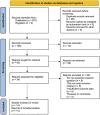Aloe vera for prevention of radiation-induced dermatitis: A systematic review and cumulative analysis of randomized controlled trials
- PMID: 36249738
- PMCID: PMC9557187
- DOI: 10.3389/fphar.2022.976698
Aloe vera for prevention of radiation-induced dermatitis: A systematic review and cumulative analysis of randomized controlled trials
Abstract
Background: Aloe vera were frequently reported to reduce the risk of radiation-induced dermatitis (RID), but the quantitative results from all the relevant studies were not presently available. This study sought to conduct a cumulative analysis to better clarify the preventive effects of aloe vera in RID. Methods: MEDLINE (PubMed), Cochrane, EMBASE, PsychINFO, Web of Science, China National Knowledge Infrastructure (CNKI), and Wan Fang Database were utilized for identifying the eligible randomized controlled trials (RCTs) without language restrictions, up to March 2022. The pooled incidence of RID was conducted by the Relative risk (RR) with its 95% confidence interval (CI) through the STATA software under a random-effects model. This systematic review and cumulative analysis were registered on PROSPERO (ID: CRD42022335188). Results: Fourteen RCTs met our predefined inclusion criteria, enrolling 1,572 participants (mean age: 46.5-56 years). The cumulative results revealed that patients pretreated with aloe vera were associated with a significantly lower risk of RID compared to those without aloe vera usage (RR = 0.76, 95% CI: 0.67-0.88, p < 0.001; heterogeneity: I 2 = 79.8%, p < 0.001). In the subgroup analysis, the pooled incidence of Grade 2-4, Grade 2, and Grade 3 RID was also dramatically lower in the group of aloe vera as compared to the placebo group [RR = 0.44 (0.27, 0.74), 0.58 (0.36, 0.94), and 0.27 (0.12, 0.59) in Grade 2-4, Grade 2, and Grade 3, respectively]. However, in regard to Grade 4 RID, the combined RR indicated that the incidence of RID was comparable between aloe vera and the control group (RR = 0.13, 95% CI: 0.02-1.01, p = 0.051; heterogeneity: I 2 = 0.0%, p = 0.741). The sensitivity analyses showed that there was no substantial change in the new pooled RR after eliminating anyone of the included study. Conclusion: The current cumulative analysis revealed that patients pretreated with aloe vera were less likely to suffer from RID than the controls without using aloe vera. Based on this finding, the prophylactic application of aloe vera might significantly reduce the incidence of RID, especially in Grade 2 and Grade 3 RID. Further large-sample multicenter RCTs are still warranted to confirm these findings and for better clinical application.
Keywords: aloe vera; cumulative analysis; prevention; radiation-induced dermatitis; systematic review.
Copyright © 2022 Wang, Liao, Zheng, Zhou, Jin and Wu.
Conflict of interest statement
The authors declare that the research was conducted in the absence of any commercial or financial relationships that could be construed as a potential conflict of interest.
Figures






Similar articles
-
Potential Benefits of Aloe vera and Raphanus sativus var. longipinnatus Gel for Prevention of Radiation-Induced Dermatitis in Head and Neck Cancer Patients.Iran J Pharm Res. 2023 Jan 20;21(1):e132213. doi: 10.5812/ijpr-132213. eCollection 2022 Dec. Iran J Pharm Res. 2023. PMID: 36896315 Free PMC article.
-
Effects of Aloe Vera in the Treatment of Oral Ulcers: A Systematic Review and Meta-Analysis of Randomised Controlled Trials.Oral Health Prev Dent. 2022 Dec 12;20:509-516. doi: 10.3290/j.ohpd.b3666483. Oral Health Prev Dent. 2022. PMID: 36504087 Free PMC article.
-
Reduction in severity of radiation-induced dermatitis in head and neck cancer patients treated with topical aloe vera gel: A randomized multicenter double-blind placebo-controlled trial.Eur J Oncol Nurs. 2022 Aug;59:102164. doi: 10.1016/j.ejon.2022.102164. Epub 2022 Jun 17. Eur J Oncol Nurs. 2022. PMID: 35767935 Clinical Trial.
-
Lack of Prophylactic Effects of Aloe Vera Gel on Radiation Induced Dermatitis in Breast Cancer Patients.Asian Pac J Cancer Prev. 2017 Apr 1;18(4):1139-1143. doi: 10.22034/APJCP.2017.18.4.1139. Asian Pac J Cancer Prev. 2017. PMID: 28547955 Free PMC article.
-
Aloe vera in treatment of oral submucous fibrosis: A systematic review and meta-analysis.J Oral Pathol Med. 2019 Feb;48(2):99-107. doi: 10.1111/jop.12789. Epub 2018 Nov 7. J Oral Pathol Med. 2019. PMID: 30329174
Cited by
-
Photobiomodulation therapy for mitigating severity of radiodermatitis in cancer patients undergoing radiotherapy: a scoping review.Support Care Cancer. 2024 Oct 28;32(11):750. doi: 10.1007/s00520-024-08944-y. Support Care Cancer. 2024. PMID: 39467916 Free PMC article.
-
The effect of various interventions on the prevention of radiation dermatitis: a network meta-analysis.Am J Transl Res. 2024 May 15;16(5):1859-1879. doi: 10.62347/XLGT5405. eCollection 2024. Am J Transl Res. 2024. PMID: 38883361 Free PMC article. Review.
-
Therapeutic effect of NEO400, perillyl alcohol conjugated to linoleic acid, in a mouse model of UV-induced skin damage.Photochem Photobiol. 2025 Mar-Apr;101(2):338-349. doi: 10.1111/php.13998. Epub 2024 Jul 5. Photochem Photobiol. 2025. PMID: 38970228 Free PMC article.
References
Publication types
LinkOut - more resources
Full Text Sources
Miscellaneous

